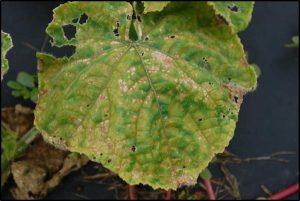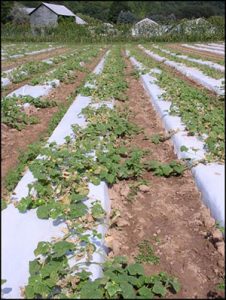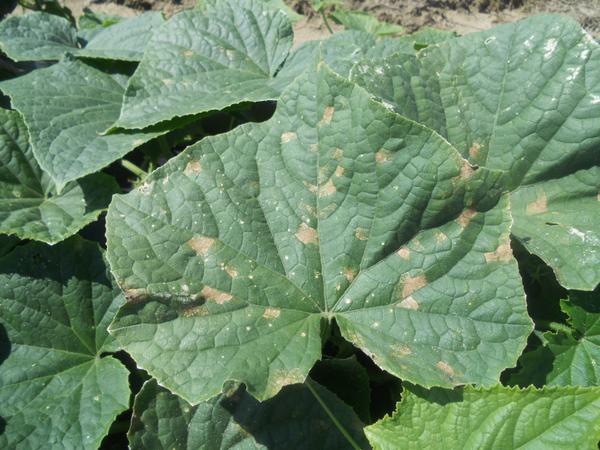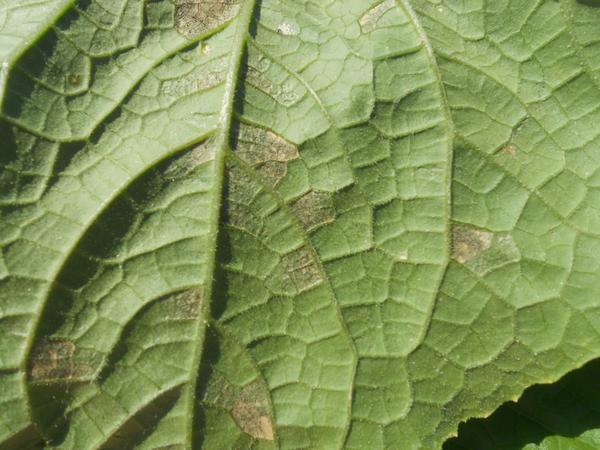Pseudoperonospora cubensis
Downy mildew causes angular, yellow to brown lesions on top of the leaves that are restricted by leaf veins. When conditions are favorable, for example early in the morning when moisture is higher, lesions observed on the underside of the leaf may be covered in dark “down”. This downy growth is masses of pathogen spores called sporangia, which can be seen in the field with a 20X hand lens. In the presence of water, sporangia can directly germinate or differentiate into swimming zoospores that infect leaves. Identification of downy mildew in cucumber can generally be done in a field setting due to the characteristic angular lesions and pathogen sporulation in the underside of the leaf. However, in crops such as watermelon and cantaloupe where lesions do not always have the characteristic angular shape, sporulation can be scarce and diagnostics can be more difficult.
Diagnostic Resources
- Diagnostic Guide for Cucurbit Downy Mildew
by: Andres Salcedo, Mary Hausbeck, Stacey Pigg, and Lina M. Quesada-Ocampo
Plant Health Progress: Vol. 21, No. 3 - Photo Gallery: Downy mildew symptoms on cucumber photo gallery – Hausbeck Plant Pathology Research Lab at Michigan State University
- Plant Disease Clinics
Plant Disease Management Reports
- Evaluation of cucumber cultivars for downy mildew management , Clinton 2022.
- Evaluation of fungicides for downy mildew management on cucumbers, Clinton 2022.
- Evaluation of fungicides for management of cucumber downy mildew, Clinton 2022.
- Evaluation of fungicide rotation for downy mildew management on cucumbers, Clinton 2022.
- Evaluation of varieties for control of downy mildew on cucumber, Clinton, NC 2021.
- Evaluation of fungicides downy mildew control on cucumber, Clinton, NC 2021.
- Evaluation of fungicides for management of cucumber, downy mildew, Goldsboro, NC 2021.
- Evaluation of fungicides for management of cucumber downy mildew, Clinton, NC 2021.
- Evaluation of single product treatments for control of downy mildew on pickling cucumbers, 2021.
- Evaluation of disease forecasters for control of downy mildew on pickling cucumbers, 2021.
- Evaluation of fungicides for control of downy mildew on cucumber, Saratoga, NC 2020.
- Evaluation of fungicides for control of downy mildew on cucumber, Clinton, NC 2020.
- Evaluation of fungicides for control of downy mildew on cucumber, Clayton, NC 2020.
- Evaluation of cultivars in combination with fungicides for control of downy mildew and yield effects on cucumber, Clinton, NC II 2020.
- Evaluation of fungicides for control of downy mildew on cucumber, Clinton, NC III 2020.
- Evaluation of fungicides for control of downy mildew on cucumber, Clayton, 2019.
- Evaluation of cultivars in combination with fungicides for control of downy mildew and yield effects on cucumber, Clinton, 2019.
- Evaluation of fungicides and cultivars for control of downy mildew on cucumber, Kinston 2019.
- Evaluation of fungicides for control of downy mildew on cucumber, Kinston II, 2019.
- Evaluation of fungicides for control of downy mildew on cucumber, Kinston III, 2019.
- Evaluation of alternating programs of fungicides for control of downy mildew on pickling cucumber, 2019.
- Evaluation of single product treatments for control of downy mildew on pickling cucumbers, 2019.
- Evaluation of 9 alternating programs of fungicides for control of downy mildew on pickling cucumbers, 2019.
Disease Control Information
- Better Know a Pest: Downy Mildew of Cucurbits – Smart Lab at Cornell Vegetables (video)
- Cornell Cucurbit Downy Mildew Management Guidelines – Cornell Vegetables (2017)
- Downy Mildew News – Hausbeck Plant Pathology Research Lab at Michigan State University
Monitoreo y Manejo del Añublo Lanoso de las Cucurbitáceas – Spanish translation - Downy mildew on cucurbits: Early symptoms – McGrath Lab at Long Island Research and Extension Center, Cornell University
- Downy mildew on cucurbits: Other symptoms and imitators – McGrath Lab at Cornell Vegetables
- The Cucurbit Downy Mildew Forecast ipmPIPE -USDA NIFA (2007 – 2019)
- Resources for commercial growers: Downy Mildew – Smart Lab at Cornell Vegetables
- Vegetable Pathology Lab Factsheets – Quesada-Ocampo Lab at North Carolina State University
Cucurbit Downy Mildew – NC State Vegetable Pathology Factsheets
Añublo lanoso en cucurbitáceas – NC State Hoja informativa de patógenos de vegetales




